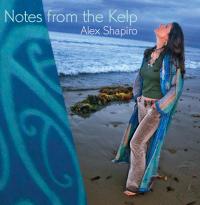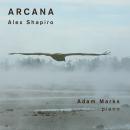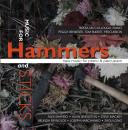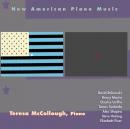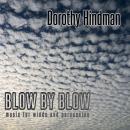Notes From The Kelp
Notes From The Kelp
Malibu, CA
| Notes from the KelpiTunes Artist's PageiTunes Album Page | |||
|---|---|---|---|
| Song Title | Time | Price | |
| 1. | Slipping | 09:31 | $0.99 |
| 2. | Bioplasm | 11:52 | |
| 3. | Current Events: I. Surge | 04:18 | $0.99 |
| 4. | Current Events: II. Ebb | 07:34 | $0.99 |
| 5. | Current Events: III. Rip | 03:37 | $0.99 |
| 6. | For My Father | 05:23 | $0.99 |
| 7. | At the Abyss: I. Observe | 06:39 | $0.99 |
| 8. | At the Abyss: II. Reflect | 04:20 | $0.99 |
| 9. | At the Abyss: III. Act | 02:44 | $0.99 |
| 10. | Phos Hilaron | 02:30 | $0.99 |
| 11. | Music for Two Big Instruments | 06:37 | $0.99 |
| 12. | Deep | 07:35 | $0.99 |
Can a composer be happy and live a balanced life filled with music, social activism and marine biology? Alex Shapiro gives us proof that such a beautiful existence is possible, and the sonic result spans an unusually wide swath of emotions. Shapiro's world is one of heart-wrenching lyricism and gut-wrenching demons. Whether her music is blatantly funny or stunningly introspective, it reaches out and attaches itself to the listener as a starfish might glom onto a rock. You won't want it to let go.
Raw perception and truth are offered here, and Alex doesn't mince notes. Her rhythms and melodies may either make you reach for your psychiatrist's phone number, or a snorkel. If music mirrors a composer’s personality, then you’ll know a lot about this one through these diverse pieces. As you listen, like the kelp-rich tide pools encircling Alex's toes, this music will show you not only a glimpse of her world, but a reflection of yours.
Alex is a seductive communicator, and "Notes from the Kelp" is a collection of chamber music representing a decade’s worth of her passionate messages. Born and raised in Manhattan, she migrated to the Pacific Ocean many years ago and has never left. The eight works on this disc were composed in Malibu, California, and well-behaved muses now convene at her home in Washington's San Juan Islands.
Alex's favorite way to procrastinate from writing the next piece has been to assist the next person. Throughout her composing career she's been an officer on the boards of numerous non-profit organizations ranging from the usual contemporary music suspects to the ACLU, and she's well known in sunny So Cal as an even sunnier host for new music events. Alex Shapiro's music has been recorded for many commercially released CDs in the United States and in Europe, but "Notes from the Kelp" is the first album comprised entirely of her works.
LISTEN101.BLOGSPOT.COM
I like this CD very much. Ms. Shapiro handles a wide variety of instruments and idioms with style and expression. My favorite piece so far is Current Events, for string quintet (adding a viola to the traditional quartet). The piece is well-written for the instruments, expressive, and compelling. Ms. Shapiro's music stakes out so much musical territory that I am sure just about everyone will find somethng to like on the program.
by Steven Hicken
TOFAKI
Fascinated by the small things: Shapiro leaves the window to her heart wide open. As a composer in the 21st century, you have digital downloads, virtual record companies, multimedia presentations, email, chat, skype, online radio stations and social communities at your disposal. It is sometimes easy to forget that you can also use music to communicate. Not so for Alex Shapiro. While she has embraced the wave of changes the internet has brought to her personally and her trade in general with arms wide open, her creed has always been that technology, electronics and fiberglass should never be treated as more than just one potential factor among many to bring joy to yourself and your listeners. Or maybe there are no borders between writing an email and a string quartet in her world – it all serves an exchange of emotions, thoughts, perspectives, arguments and impressions. It is therefore a logical step to release this CD as an addendum, enhancement, deepening or aural continuation (take your pick) of her audiovisual blog “Notes from the Kelp”. Since moving to Malibu, California, Shapiro has shared private details, moments of bliss, musical ponderings and the adventures of her cat with visitors on the web – now she is giving away even more. “If music mirrors a composer’s personality, then you’ll know a lot about me through these pieces”, she says in the linernotes. One thing can however already be claimed without listening: It takes a lot of courage to leave the window to your heart this open. How easy it is, after all, to hide behind abstractions and metaphors, how convenient to seek shelter in the shade of some obscure niche. Alex Shapiro hasn’t broken with tradition, but her approach to writing seems to be that at the end of the day, you’re not a minimalist, an atonalist, a serialist, a romantic or a neoclassicist, but a human being with very human desires. On the one hand, “For my Father”, a document of a gradual descent into dementia, is a dark episode, an eerie and questioning motive spiralling helplessly down into bitter acceptance. On the other, there is “Slipping”, a hilarious dance of styles for violin, harpsichord and “very mixed” percussion. And between these poles, there are no bone-dry theories, but lots of sensual shadings. “Bioplasm”, her twelve-minute long flute quartet, for example, jumps into a kettle of primordial soup, dabbling and splashing in agitated rhythms, cloudy ambiances, dense textures and open outcries. The flutes combine into a mysterious surface area, all undulation, ripples and bubbles, obscuring the individual melodic lines into a surreal sort of audioplankton. On “Deep”, an electro-acoustic voyage with cinematic aspirations, she sends Leslie Lashinsky’s bassoon towards the centre of the earth, its goblinoid resonances drilling softly downward. “Phos Hilaron”, finally, is a harmonic statement of great purity and simplicity, a circularly drifting cloud of winds and pianos. So, based on these works, what kind of a person is Alex Shapiro? Well, to give you a rough impression, how about this: She’s impulsive, romantic, curious, both educated and naive, humorous and serious, stern and silly, pensive and relaxed, complex and easy, fascinated by the small things yet with a wish to change the world, in love with nature but unafraid of technology, generous yet demanding and grateful for so much. Oh, and she probably likes to dance, but to the strangest of grooves. It fits this description well that she sees the job of a composer both as the most lonely and social there is. Maybe this is also why she takes the aspect of communication so seriously. When you’ve spent so much time with yourself, it is the feedback from others that tells you that you’ve been producing something valuable – instead of egoistically indulging in a form of “socially accepted insanity”.
by Tobias Fischer
CHAMBER MUSIC AMERICA
As sheltered a life as I’ve led in the obscure shadows of the new- music world, I have never before met anyone with a bio like Alex Shapiro’s. One way of looking at it is that she used to be successful—and gave it up. That is, she worked in TV and film, and used to make a living off her music. She wrote the score to the Timothy Bottoms family film Horses and Champions, and she’s done projects for Sony Television, the Turner Broadcasting Network and the American Film Institute. She was a recording booth supervisor for the Star Trek TV series. Go to her slickly produced website, www.alexshapiro.org, and she’ll treat you to mp3s of her title music for the TV shows Most Wanted and Courthouse, and for the television documentary Behind the Scenes at People Magazine. (I would have thought I could write this column the rest of my life without ever making a reference to People Magazine.) And it sounds just like what you’d expect from TV: snappy, upbeat, gotchyer- attention tunes in technicolor production. Shapiro has tech skills and style informa- tion that most classical composers can only wonder at. She’s made jazz arrange- ments and written pop songs. And nine years ago, she walked away from that life to enter the cloistered, unremunerative world of the classical composer. She got tired, she says, of massaging producers’ egos, and she wanted complete creative control. It wasn’t an illogical move; in ear- lier years she’d studied at Juilliard and Manhattan School of Music with Ursula Mamlok and John Corigliano. The ques- tion isn’t so much why she writes tons of chamber music now as how she got sucked into such a commercial detour in the first place. This unusual background has given Shapiro a lot of chops. We know what we mean when we attribute “chops” to a saxophonist or bass player, but the term turns awfully vague when applied to composers. What it means here is a close familiarity with a wide range of instru- ments, and the ability to do things with them you wouldn’t expect. For instance, I was quite taken with her piece Bioplasm from her new CD, Notes from the Kelp(on Innova, and more about kelp later). Listening to it while going about my business, I gathered that it was a large ensemble piece for exotic percussion, voices, winds, maybe even electronics. Imagine my surprise, upon looking at the score later, to find that it’s merely a flute quartet! It starts and ends with a calypso- like texture of booming alto and bass-flute key clicks (those were my imagined hand drums), and has sections in which the flutists hum and sing while playing. And since there are passages of growling, pitch-bending techniques in low register breaking into suave glissandos in both directions, it’s easy to see how I was so completely fooled. The other result of Shapiro’s unusual background is her complete lack of ideo- logical affiliation. Trained for infinite versatility, she can write any kind of music she wants, and she writes only what she wants. Nowhere does one run across a hint of minimalist influence, or serialist, or neoclassic, or postmodernist, or jazz, or for that matter TV or film music. It’s all just Alex Shapiro music, which is not, however, to say that it’s all closely unified by style. In contrast to the concept-based brilliance of Bioplasm, her Current Events for string quintet is deeply Romantic in an almost early-Schoenberg way, while her Piano Suite is thoughtfully atonal, imagistically dissonant in a way that brings Carl Ruggles to mind. Her website includes a disclaimer that “Stylistic diversity shouldn’t cause a composer to be taken less seriously,” and her music makes that argument well. All the same, she might well be warned that, in a music world in which many composers try to brand themselves through stylistic uniformity, listeners might find her diffi- cult to pin down. If there’s a unity here, it is more pro- grammatic than procedural. Shapiro lives on the ocean, on Washington State’s San Juan Island, loves it, and lets you know about it. Not for nothing is her CD titled Notes from the Kelp, and she seems to be practically dripping with seaweed in most of her photos. Current Events is a punning title about the sea, whose ultra- romantic Adagio is marked “Gazing at the still tide pools.” A movement of the Piano Suite bears the slogan, “Adrift at sea; a distant foghorn signals hope....” A climax is marked “The storm arrives.” The centerpoint of Shapiro’s personal kaleidoscope of styles is an inwardness that relates to a specifically aquatic form of nature-worship. Her music is at its best when it seems to be musing, reminiscing, meditating on a vast liquidity—as it almost always is. Appropriately, one of her most remarkable works is simply entitled Deep, written for contrabassoon and electronic soundtrack. There is nothing “bassoon-y” or even soloistic about it. The electronic timbres are so mystically sepulchral that they fold the contrabassoon into them- selves, and you really have to watch the score to be sure what the soloist is playing and what’s on the accompanying sound track. The piece broods with a slow wan- dering that seems formless, yet it does keep returning to motives archetypal enough as to pass by unmarked. And the sound pro- duction is so superb that you could pass the piece off as a really outside-the-box pop record, like a long-lost Brian Eno track. Surely this is the best solo contra- bassoon piece ever written—though I admit I make the claim never having heard another one, that I can recall. In lieu of an instantly recognizable idiom, Shapiro has tremendous technical skills, a deep connection to nature, and an engaging and articulate personality that has gotten her multifariously involved in the new-classical-music world that she had left behind for a while. She gets more performances than any one person could attend, and despite her nature wonder- land she’s socially inclined, a frequent presence on the Sequenza 21 website. She came roaring back from the commercial world we almost lost her to, and is making this new composer’s life as active and exciting as the one she left behind.
by Kyle Gann
SEQUENZA 21
Alex Shapiro is a NYC expat now living on an island off of Washington State who writes what has been described as “midtown music” for lack of a better term. In her words, Alex’s music lies somewhere in the canyon between downtown and uptown. I think the reality is somewhat different—Alex Shapiro’s music doesn’t need to be categorized; it should be listened to on its own terms. This is a very personal album, the first one exclusively devoted to her music, and one that provides a wide range of Alex’s works spanning a number of years. It asks the question “Can a composer be happy and live a balanced life filled with music, social activism and marine biology?” Apparently, the answer is a resounding “yes.” There are a lot of works on this CD, including pieces for electronics as well as acoustic instruments. Of all the pieces, the two that worked most for me were Current Events for string quintet and Music for Two Big Instruments (piano and tuba). The tuba works very well in this piece, and it’s great to hear the instrument being used so lyrically and in a way that it is so exposed. The string quintet was nicely written for strings and is a compelling work of music. The other items were great to listen to and probably will grow on me after even more repeated listening. There is a wide range of styles that makes this album diverse enough to have something of interest for anyone. There is also a great range of instrumentation, including strings, winds, (very mixed) percussion, piano, electronics…even a harpsichord. The piano work For My Father is particularly compelling. I should also say that the performances can be assumed to be definitive, being supervised by the composer. So unless Alex blew it and didn’t pay attention, this is as good a set of performances of her music as it gets. You’re not going to find postminimalism on this album, or totalism, or serialism, or whatever. It’s just pure music, and there’s nothing wrong with being a movement of one.
by David Toub
ALL MUSIC GUIDE
West Coast composer Alex Shapiro writes that "Composing is a lot like making love. We're trying to please ourselves. We're hoping to please at least one other person. And we are, in fact, communicating. Passionately." You didn't hear this stuff from Milton Babbitt! But in fact there is a modernist component to Shapiro's music, wedded here to the nature imagery that living in California seems to inspire (all the music was composed in giddy Malibu). Her music is hard to classify -- it is in no way West Coast minimalism, and each piece has a distinct idea that may be worked out to quite a level of complexity. Something is happening almost all the time, and she rarely repeats material. On the other hand, it is tonally centered, it couldn't be called difficult, and a good deal of it is flat-out fun. Hear the opening Slipping, a work for violin, harpsichord, and "very mixed" percussion in which the harpsichord imitates a worldwide variety of stringed instruments in a rollicking, upbeat ride. Most of the music on the disc, including the punningly titled string quintet Current Events, vividly depicts natural forces; Deep, the sole electronic work on the album, teams a contrabassoon and electronics in a marvelously evocative depiction of the composer's experiences scuba diving in Belize. At the Abyss, for piano and percussion, embodies a program of responses to the threat of environmental catastrophe, with three movements entitled "Observe," "Reflect," and the resolute "Act." The most serious work on the album, the solo-piano For My Father, depicts the descent into dementia of the composer's father; here again Shapiro is both emotionally immediate and capable of sustaining a structural process over a long stretch. This ought to make a good introduction to the eclectic music of the present day, which embraces audiences as resolutely as the composers of the 1960s and 1970s rejected them, and it's enough to give one hope for the contemporary music scene.
by James Manheim
SOUNDS & FURY
At the composer’s request, we were recently sent a review copy by Innova Recordings, the recording arm of the American Composers Forum, of a just released CD titled, Notes from the Kelp, an album devoted to eight chamber works by the contemporary American composer Alex Shapiro. As regular readers of Sounds & Fury are aware, we as a rule don’t do CD reviews here, and our interest in and enthusiasm for contemporary classical music is just about nil. But the contemporary classical music works on this CD immediately compelled our attention because of their utter lack of doctrinaire adherence to any of the manifold modern and postmodern isms today floating about in the world of classical music, and gave evidence of not so much as a trace of the obsession with process and sound that so malignantly infects so much contemporary classical music today. It’s not that we imagine the 45-year-old Ms. Shapiro is unaware or ignorant of any of these tendencies, but rather that we sense that her fundamental and overarching concern is with musical ideas and their spinning out rather than with musical and quasi-musical effects, which is not to say she’s above using either or both when she determines they’ll serve her musical ideas advantageously and well. As a happy consequence, there’s nothing in this collection of well-made chamber works — all of it very much of the 21st and late 20th century — that one could call or mistake for avant-garde innovative. All these works are, to use a ubiquitous buzzword in music criticism today, accessible, and absent any of the extreme complicatedness masquerading as complexity that’s part of the working kit of avant-garde charlatans such as Babbitt, Boulez, and Stockhausen and their ilk. If one was forced to chose one adjective to characterize all these chamber works, that adjective would be, beautiful. Even the opening comic piece, “Slipping” — scored for violin, harpsichord, and percussion — is no exception having as it does its own zany sort of beauty. It’s a madcap, half-demented romp through a potpourri of styles ranging from early-‘50s rock-and-roll, to Italian street song; from ‘40s jazz to Japanese koto music in all of which the harpsichord is called upon to impersonate every imaginable plectrum instrument — except the Baroque harpsichord. A thoroughly delightful frolic, expertly and with relish performed by Robin Lorentz, violin (who commissioned the work as a gift for her recital partner, Kathleen McIntosh); Kathleen McIntosh, harpsichord; and Dan Morris, percussion. Perhaps it’s just our mildly weird sense of humor, but we couldn’t help thinking that an integral bookending of this mélange by a single po-faced fragment on both ends in the style of a Bach trio sonata (sans percussion, of course) would have given sharper point to the work’s musical idea, and made the comic wackiness in-between that much more piquant. Far from comic or wacky is “Bioplasm”, the next cut on the CD. It’s an eerie and curiously haunting tone poem written for flute quartet — 2 C flutes, 2 alto flutes, 2 bass flutes, and 1 piccolo — that incorporates some uncommon flute techniques such as percussive pitched key clicks and pitch bending (the latter sounding just as the words suggest, and both new to this writer) as well as vocalizations by the players while they’re playing (no, we have no idea how that’s done, but we’re assured that no overdubbing was employed, and that none of the four flutists were harmed in the making of the recording), that requires more than one listening to appreciate fully in all its details. The centerpiece of Notes from the Kelp (for us, at any rate) is “Current Events”, three thematically and musically related essays on the sea written for string quintet (2 violins, 2 violas, and 1 cello). Moving quickly past the cutesy double entendre title which ill serves the sense and depth of the work, the three named movements are “Surge”, “Ebb”, and “Rip”, all referring to ocean tidal currents (“Current Events”, get it?). The musical language shared by all three is richly dissonant and dark-textured; a dense polytonal chromaticism that’s gorgeously and unabashedly romantic and deeply affecting. If there’s but one work on this CD that all will love, this is it, and were it the only work on the CD, it alone would justify the purchase price. “For My Father” is the fourth movement of Ms. Shapiro’s 1996 five-movement Piano Suite No. 1: The Resonance of Childhood, and the sixth track on this twelve-track CD. It’s an elegy on the inexorable descent of Ms. Shapiro’s father into dementia — an anguished, extended questioning of fate ending in quiet resignation the totality of the movement seeming to echo the sense of the words if not the original meaning of Beethoven’s famous written question and answer on the beginning and ending pages, respectively, of the last movement of his last quartet: “Muss es sein? Es muss sein. [Must it be? It must be.]” Three reflections on the present state of our species and its relation to our planet are the substance of “At The Abyss”; a work scored for piano, marimba, vibraphone, and percussion. The three named, complexly contrapuntal movements are, “Observe”, “Reflect”, and “Act”. The first is mad as hell, and the second and third, determined not to take it any more. Note the ethereal upper-partial harmonics in “Reflect”. They’re produced not by a glass harmonica as first thought by this writer, but by bowed rather than struck crotales; small (3”-4” diameter), tuned, cymbal-like percussion instruments that can be had in a chromatically-tuned-octave set. “Phos Hilaron” (Gracious Light) is the second movement of Ms. Shapiro’s 1999 six-movement Evensong Suite, and is scored for flute, clarinet, bassoon, and piano. This lovely Anglican liturgical piece celebrates, within its liturgical Evensong service context, “the last vesper light of a setting sun,” as Ms. Shapiro puts it. But as with all the works on this CD, its putative meaning is malleable, and outside of its liturgical setting one should feel perfectly free to assign to it anything whatsoever it might call to mind. As preparation for the next cut on this CD, first think of two really big instruments, and then mentally pair them in a duet. Bet you didn’t think of a piano and a tuba. But Ms. Shapiro did, then imaginatively named the resulting duet, “Music for Two Big Instruments”. And a more surprising lyrical pairing would be hard to imagine except it be the music of Ponchielli’s “Dance of The Hours” and Walt Disney’s impossibly graceful hippo ballerinas. Say what? A lyrical tuba? Betcherass — and beautifully, too. “Deep” is the last cut on this CD, and the only work to utilize a prepared (by the composer) electronic track over which musically lavish electronic track a solo contrabassoon does its solo turn. It’s a deeply and darkly mysterious work that will make the hair stand up on the back of your neck, we promise you. This is electronics put to proper use in the making of music, and if we hear so much as a whisper of the phrase “movie music” from any of you, we’ll write you off as a woodenheaded, hopelessly music-deaf philistine, and have nothing further to do with you. All the musicians taking part in the making of Notes from the Kelp — and there were some 22 of them if my count is not in error — performed splendidly, and splendid as well were the audio engineers responsible for capturing those performances, laying them down on digital tape, and transferring them flawlessly to CD. Innova Recordings and everyone involved in the making of this CD have much of which to be proud. The CD may be purchased directly from the composer, or individual tracks downloaded, here as can supplementary materials (such as the scores) be downloaded and much information found on the music and the making of Notes from the Kelp. The CD is available as well from Amazon here. One final word about Notes from the Kelp. Do not be fooled by the fact that Ms. Shapiro is a regular babe (that girl on the album cover is not a model, but the composer herself), nor by Ms. Shapiro’s CD liner notes and her comments on the CD’s web page which might lead one to conclude she’s little more than a utopian, tree-hugging, Left Coast flower child; a relic of the post-Woodstock ‘70s and all that implies. Listen to the music, not the words. The music says it all. The rest is silence.
by A.C. Douglas
WE ARE ALL MOZART BLOG
I finally had the opportunity to sit down with [the] new CD from [one] of my favorite composers, Alex Shapiro. Alex's recording is acoustic and uses a wide acoustic palette.I like [her] work especially because [she is not] afflicted with the Masterpiece Syndrome, making points and expounding theories and showing evidence of every micro-moment of struggle. No, that doesn't mean the work is shallow, but rather that it has extricated itself from the romantic notion of composer and composition that swept all the way through the end of the Twentieth Century. Slipping is for violin, harpsichord and "very mixed percussion" -- and is just as mixed in style as it slips from one to the next. Using various harpsichord stops and techniques, Alex creates nine minutes of, well, fun. There's serious writing (and enormous technique and a great ear) involved, but more than anything, it's an entertainment. Perhaps my favorite piece for listening is Bioplasm, which I first heard on Kalvos & Damian several years ago. This piece explores flute techniques (including noises, voices and multiphonics) in a tightly wrought architecture that feels leisurely and attractive on its surface. That's what I like about Bioplasm, for quartet of flutes (bass, alto, soprano and piccolo): It doesn't make experimentation into hard work. Of course it's instantly reminiscent of Anne La Berge's 1996 fixiation for alto flute and recorded flutes -- but there the similarity ends. Where fixiation has a clear avant-garde backstory, Bioplasm approaches the music with (dare I say it) a film composer's ear. In other words, I am not conscious of the music so much as the sensation; in Anne's piece, I hear it as a listening demand. Both pieces belong in the repertoire of any flute ensemble. The string quintet Current Events is where Alex's architectural mastery comes into play. Last year I asked Alex to critique my string quartet L'Estampie du Chevalier, and her careful prose pointed up one thing strongly: that it was sometimes wasteful of notes (I paraphrase). Though I didn't change it (we couldn't be more different as composers, save for our commitment to our art), I understand what she means after hearing her string composition. In Current Events, she does not waste notes. All are purposeful and directed. It's an interesting anomaly, because where she repeats phrases or shapes, the weight of that repetition is felt in the substance of the composition. About this she writes poetically, that the music "ponders the ocean's tides as well as waves of a more internal, emotional nature." I agree; the thematic material is highly expressive (the end of the second movement is a model of expressive composition, and should be studied by any composer to discover how to achieve effect without pretense) and she has the string quartet in hand in the way George Rochberg used to -- large, lush harmonies paired with driving rhythms and contrapuntal clarity. No Ars Nova counterpoint here -- it's fragmentation and a driven response, unfettered by some imaginary audience awaiting the pabulum of the accessible. This piece has guts through and through. Alex has also created a marvelous program. After the emotionally relentless Current Events, she follows up with the deceptively simple For My Father. It's an expansive tone poem, with plenty of open space, quite the opposite of the string quintet. It's also pianistic, which is why Alex's work is notable. She handles each instrument as if it were her instrument. She's a flutist, right? No, a string player. No, a pianist? Which? I actually don't know, but my guess is none of the above. And then comes Bartók mode. At the Abyss (piano, marimba, vibraphone and percussion) is another work broken into short, complete, and economical movements. The first movement tumbles, and the second is, yes, Bartókian "Night Music". Perhaps it was Alex's sub-surface understanding of world events, as this was written when there were "many sad, threatening and violent events throughout the world" -- as with Bartók. And the effect of bowed metallophone (not sure whether it's vibe or marimba) is not to be missed. And for the non-Bartók part, listen to the last movement's riffs and jazz harmonies. Nice. Alex only teeters on the dangerous edge with Phos Hilaron, part of a larger suite. Out of context, it's hard to tell whether this movement succeeds. I shouldn't talk; it sounds a little like my work. But what I mean is that the work is so subdued in full-frontal music-ness. Oh yes, it's expressed beautifully. Just incompletely. Music for Two Big Instruments -- tuba and piano -- is brilliantly crafted. I love the tuba, and have written several pieces for it (a sonata, a quintet, a half-hour excursion with dance and electronics, and the WAAM piece for youth ensemble featuring tuba), recognizing that, despite its ungainly reputation, it is flexible and lustrous. It takes commitment to be other than clever, and Alex has it. She treats the tuba exactly like a French horn with an extended lower range, but takes advantage of its power without losing lyricism. Finally comes Deep. And it feels exactly like the crucial moment of a film when the hero escapes disaster and, out of the corner of the eyes, sees the villain, injured but alive, slip into an escaping vehicle. You know there's a sequel -- and in the case of Notes from the Kelp, I hope there is. Deep, for contrabassoon and electronics, uses the wide soundscape sensibility and orchestral panorama with a tonal orientation. This is no acousmatics, but it's also no "Hearts of Space" twaddle. Out of a haze in a reverberant field comes the contrabassoon and long, slow pitches rising from and fading into the haze. The pitches slowly stitch themselves into a melody, and recurring percussive sensations in the distance resolve into open intervals and even chords. I'm just reading Luigi Agostini's Creare Paesaggi Sonori, and realize that in all his talk of technique, he rarely touches on the depth of imagination required for a compelling experience.
by Dennis Bathory-Kitsz
